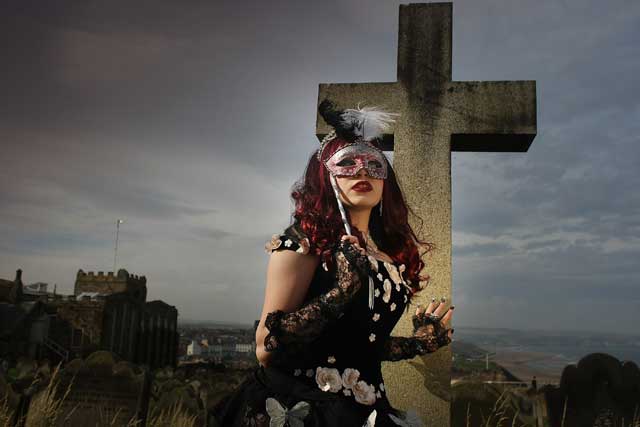The wind came wheeling across the harbour, clipping headlands, tossing seagulls into an ecstasy of screeches. Fish and chip smells curled invisibly over the bridge that spanned the river Esk. I gulped the air. Welcome to Whitby, North Yorkshire's gem, storm-tossed and marvellously British. Then the sun came out and spoilt it.
"Smashing day," said the tiny woman queuing beside me outside the Magpie fish and chip shop. "Perfect weather for a cape." Her face was white, her lips were black, and her name was Lucy. She was a goth. "I'm here for the Goth Weekend. Twice a year," she said. "The other one's due on Hallowe'en."
In the Magpie's restaurant, goths were crooking little fingers, supping tea, devouring heaped platefuls. I told Lucy that I was chasing the past, following the literary footsteps of Caedmon the poet. He was big here.
"Never heard of him," Lucy said. I tried Captain Cook, Whitby's illustrious former son and England's greatest explorer. "What did he write?" she asked, then added, "Only joking."
I escaped with haddock and chips, committing gluttony all the way along the harbour front, gazing up across the phalanx of bobbing masts and the crazy tickertape of birds, towards tiers of cottages climbing the hill to the jaw-boned cliffs above the North Sea. There stood the silhouetted abbey, the site of Caedmon's ancient cross. Just then a pensioner in vampire attire appeared and didn't give me a second nip.
Whitby plays host to tourists of every disposition. An open-topped tour bus – laden with trippers – blazed past in the distance; a gothic hearse, its coffin open, stalked the riverside. At the harbour-mouth a bungee jumper swung like a human pendulum, scaring the fish.
Yes, Whitby, with its pretty bunched-up medieval streets, was surviving its twice-annual invasion; its taverns and cafes, its little butchers' shops selling pork scratchings, were crowded with buyers. All along Church Street, bijou galleries selling jet (a polished black stone), or paintings and guidebooks, and home-made fudge, were proving the point: it was "business as usual". The exception was the candy floss, which – in honour of the Gothic weekend, I presumed – had undergone a blue rinse.
After that, I ran into a posse of noisy Australians who were also chasing Cook's ghost. They pored over maps of his famous voyages in the bookshops along Grape Lane – so twisty and dark it was once called "Grope".
Others crowded the small museum that had reputedly been Cook's lodgings back in 1746. Its exhibits include Cook's effigy, his charts and letters home, and Pacific islanders bare-breasted in an etching.
From the attic window I stared past the cluttered memorabilia and gazed – as Cook might have done from his hammock – at a seagull perched on a chimney. And I sniffed the sea.
You can't miss the sea, wherever you stand: its scent, its murmuring presence. It once made Whitby a thriving whaling port, it brought pilgrims here, and these days children splash and dabble at its edge by the west pier beach. They appear unaware that Count Dracula was once shipwrecked within the shadow of the cliffs in Bram Stoker's flesh-creeping haunted-horror tale.
Stoker, it is said, slept in the graveyard of tiny St Mary's, the church perched high in the shade of the abbey, and dreamt his spectre into existence. I climbed the 199 steps from the cobbled wynd at the end of Church Street, and then, leaden-footed, turned to look back. Tarnished headstones, black with age, their inscriptions faded, lay all around me, exuding a gothic sense of detachment; a toy-sized fishing boat ploughed its furrow towards the horizon. And there, from its plinth on the farther headland James Cook's statue raised one arm, or so it seemed.
The abbey dominates everything. It looms. It's tried to update itself with an interactive visitor centre. But 1,400 years of crumbling atmosphere haunts the site. Walking the ruins, I couldn't wait to slip back to the town, pausing only to read the inscription on Caedmon's cross: "The Father of English Sacred Song, fell asleep hard by, 680."
St Mary's church was full of old box-pews and rumours of Cook. I lit a candle, not knowing why, then began my descent.
In the Duke of York inn at the base of the steps, I sat in an alcove. I was surrounded by pictures of Whitby's past: the wreck of the Demeter, Dracula's vessel; sepia photographs of 19th-century graft; Cook's ship, the Endeavour.
I supped a pint of Black Sheep ale, staring out at Whitby, no longer in sunshine, intensely itself.
Two windswept goths came in looking hungry. The vampire-lookalike said to the barman with breathtaking aptness, "Any chance of grabbing a bite?"
Outside, a donkey padded across the sands, its tiny passenger clutching a spade. A new generation cutting its teeth on English grit.
Travel essentials: Whitby
Staying there
* Whitby Lighthouse-keeper's Cottage (01386 701177; ruralretreats.co.uk). Two nights starts at £377.
Eating & drinking there
* The Magpie Café (01947 602058; magpiecafe.co.uk)
Trenchers Seafood Restaurant, New Quay Road (01947 603212; trenchersrestaurant.co.uk).
Visiting
* Captain Cook Memorial Museum, Grape Lane (01947 601900; cookmuseumwhitby.co.uk). Adult £4.50, child £3.
Whitby Abbey (01947 603568; english-heritage.org.uk). Adult £5.80, child £2.90.
* Whitby Gothic Weekend takes place 29-31 October (wgw.topmum.co.uk).
More information
* Whitby Tourist Information: 01947 602674; visitwhitby.com

Join our commenting forum
Join thought-provoking conversations, follow other Independent readers and see their replies
Comments